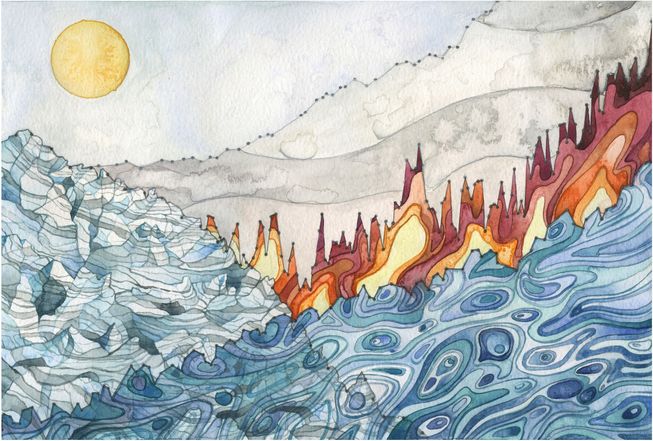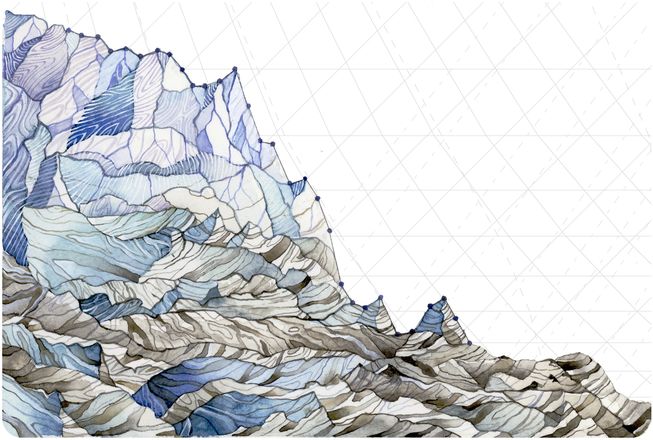Glaciogenic Art
Jill Pelto's watercolors illustrate the strange beauty of climate change data
Courtesy of Mother Nature Network
November 8, 2016
- For more about Jillian's art -- https://www.etsy.com/shop/GlaciogenicArt / http://www.jillpelto.com/gallery/
- (Photo: Jill Pelto)
Landscape of Change' was painted using data about sea level rise, glacier volume decline, increasing global temperatures and rise in fossil fuel usage.
GlaciogenicArt
Communication of Scientific Research through Art
Artist and scientist Jill Pelto, 23, hopes to inspire people to take action by imbuing her dreamy watercolor paintings with hard scientific data and field research.
In one of her most evocative pieces, "Landscape of Change" (above), Pelto illustrates the interconnectedness of our planet's natural resources using real data about rising sea levels, glacier volume decline, increasing global temperatures and fossil fuel usage.
While there are plenty of artists inspired by the nature around them, Pelto is uniquely positioned to create this kind of work. In addition to graduating with a double major in Earth science and studio art at the University of Maine last year, she's also participated in a number of research trips that took her to the glaciers of Washington, the rolling hills of the Falkland Islands and even the otherworldy dry valleys of Antarctica.
Pelto hopes that by highlighting threats to the environment in her work, she can raise awareness and inspire viewers to think critically about the very serious issues that face the planet and its inhabitants.
Intrigued by the beauty of these paintings, we reached out to her to learn more about her and her work.
MNN: Can you tell us a little bit about your background?
Jill Pelto: I grew up in Worcester, Maine, hiking and playing outdoors and drawing constantly with my sister. My mom is a creative with passions for the outdoors and art, my dad is a glaciologist and works at Nichols College, and my stepmom is a visual communications teacher and potter. I have a twin sister who majored in illustration, and an older brother who is working on his Ph,D. on glacier retreat in British Columbia. So, I am right in the middle of my family’s interests with my dual studies of art and science.
MNN: What fostered your interest in science and art?
My interest in science began through working with my dad, Dr. Mauri Pelto, on his North Cascade Glacier Climate Project in Washington. I joined him at 16 and haven’t stopped assisting since. This August was my 8th field season with the project!
Prior to fieldwork, I always loved the outdoors, but I truly developed an affinity for science through my opportunity to measure the changes in the glaciers over the years. This experience opened my eyes to the impacts of global warming and ignited my desire to study the sciences in order to learn more about what was happening to Earth. Art has always been my passion, more than anything else. I have never stopped creating and imagining, and I never will. Once I was in high school, I knew without a doubt that I would pursue a career as an artist.
MNN: In college, what was it like to balance your formal study of Earth science and studio art? Were you able to find ways to make them naturally complement each other?
In my life, I have always found art and science weave together well; in college courses, this is less the case. It was difficult to balance these two degrees, but the challenge was well worth it. Running from painting class across the campus to mineralogy, it was difficult to get my brain to switch modes. This certainly developed both sides of my brain in tandem, though! Further in my college career, my artwork really started to reflect my studies in the Earth science department, so while courses still clashed, I finally began to figure out how these two majors could really work together [toward] a career.
MNN: What initially inspired you to incorporate graphical climate change data in your work?
This inspiration accumulated over the years. In the sciences, I had to read and create many graphs. For me, they are interesting and very communicative. After returning from glacier fieldwork in Washington [in August 2015], I wanted to create a series about the devastating effects of the drought on the state. Researching this topic further, I realized I could actually incorporate my dad’s research graph of declining glacier size.
It seemed a fairly straightforward idea initially, but after creating the work, the reaction from my classmates told me I had hit on something powerful. I realized that most people don’t pay attention to or readily understand graphs as I have learned to do. By using graphs in a simple way, and including aesthetic imagery, I was able to combine intellectual information with an emotional response.
MNN: How do you determine what topics to tackle or which studies to cite?
So far, it has been simply been topics that I learn about that I envision as an art piece. There are countless environmental issues I could address, so I am trying to choose a diverse group that convey a message effectively. I am beginning to collaborate with other scientists, so in the near future, I also will be making artwork about their research topics. My hope is that this work will help draw more attention to the science that they do.
MNN: Is there a piece you’re especially proud of?
Personally, as an artist, the way I view my work changes. Most days when I look at it, I’m very proud, but some days I doubt myself. Overall, the reason I am proud is because I know how challenging it was to develop my portfolio. It took me years devoted to thinking about the communication of science through art to begin to touch upon ways to do so. I have sketched, written and painted so many works of art, all of which led to the development of my current work. I know I am just beginning my career as well, so I am excited for my growth as an artist.
If I have to choose one piece, it would be "Decrease in Glacier Mass Balance," the first data driven piece I designed.
This painting isn’t my most popular, but it has a special place for me. I love the way I chose to illustrate the glacier, whose profile reflects the data of glacier mass balance decline over the past several decades in the North Cascades, Washington. Since I have been involved with working on these glaciers, I have a personal connection with them and with the research. I am proud of this representation of their history.
MNN: Are there any scientists, artists or science communicators that you’re inspired by?
Very many! I am inspired by many of my professors in the Earth science department at UMaine. Dr. Brenda Hall will be my adviser while I receive my Masters of Science, and I have been fortunate enough to work with her on several field projects. She is relentless in her curiosity and search for the understanding of Earth’s paleoclimate in regards to glaciations. I am inspired by my dad’s creation of the North Cascade Glacier Climate Project, which he has conducted for 33 consecutive years.
There are many other scientists who I have met, and whose work I have read, whose research inspires me to better understand the natural world, and fight to protect it. I completed an honors thesis project in the form of a research paper and a large portfolio of artwork to end my undergraduate career. My paper was titled "Art as a Tool to Communicate Science," and I researched dozens of artists for it. Some of my favorites are Zaria Forman with her massive pastels of icebergs, Toni Hamel with her clever and mocking illustrations, and Chris Jordan with his powerful imagery of mass consumption. I am just learning about the community of people from many disciplines who work to understand and protect the world’s ecosystems, and I am so excited to join the effort!

